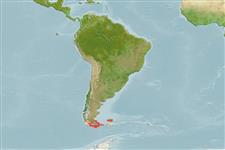Environment: milieu / climate zone / depth range / distribution range
Ecología
marino demersal; rango de profundidad 40 - 50 m. Temperate; 52°S - 57°S
South Atlantic and South Pacific: Straits of Magellan, south of Chile and Argentina, Patagonian Region and Staten Island. Falkland Islands and subantarctic islands (Ref. 4537).
Tamaño / Peso / Age
Maturity: Lm ? range ? - ? cm
Max length : 9.5 cm SL macho / no sexado; (Ref. 117667)
Mainly in shallow, inshore waters, but may be found from 40-50 m. Occurs in tide pools, under rocks and among kelp (Ref. 5191). Feed on small crustaceans and common in littoral of all sub-Antarctic islands (Ref. 42041).
Life cycle and mating behavior
Madurez | Reproducción | Puesta | Huevos | Fecundidad | Larva
Females guard the eggs deposited in a nest they constructed for the four month incubation period (Ref. 89358).
Hureau, J.-C., 1990. Harpagiferidae. p. 357-363. In O. Gon and P.C. Heemstra (eds.) Fishes of the Southern Ocean. J.L.B. Smith Institute of Ichthyology, Grahamstown, South Africa. 462 p. (Ref. 5191)
IUCN Red List Status (Ref. 130435)
Threat to humans
Harmless
Human uses
Pesquerías: sin interés
Más información
ReferenciasAcuiculturaPerfil de acuiculturaRazasGenéticaElectrophoresesheritabilidadEnfermedadesProcesamientoNutrientsMass conversion
ColaboradoresImágenesStamps, Coins Misc.SonidosCiguateraVelocidadTipo de nataciónSuperficie branquialOtolitosCerebrosVisión
Herramientas
Special reports
Download XML
Fuentes de Internet
Estimates based on models
Preferred temperature (Ref.
123201): 6.2 - 8, mean 7.1 °C (based on 8 cells).
Phylogenetic diversity index (Ref.
82804): PD
50 = 0.5010 [Uniqueness, from 0.5 = low to 2.0 = high].
Bayesian length-weight: a=0.00537 (0.00211 - 0.01367), b=3.10 (2.88 - 3.32), in cm total length, based on LWR estimates for this (Sub)family-body shape (Ref.
93245).
Nivel trófico (Ref.
69278): 3.3 ±0.4 se; based on diet studies.
Resiliencia (Ref.
120179): Medio, población duplicada en un tiempo mínimo de 1.4-4.4 años (Assuming Fec < 10,000).
Fishing Vulnerability (Ref.
59153): Low to moderate vulnerability (35 of 100).
